No Such Thing as a “Typical” Day
Several people have asked me, “what is a typical day for you at the South Pole?” Well, the answer isn’t so simple. I’d say there really isn’t a “typical” day – each day is different. Let me give you a glance into just one day I’ve experienced at the South Pole.
1:30am-3:30am – Internet Access
I wake up to the annoying sound of my alarm and quickly turn it off. The walls of the dorm rooms are quite thin and I don’t want to wake my neighbors. It’s pitch black in my room thanks to the cardboard over my window. I pull it back a crack and sunlight pours in as if it’s mid-afternoon.
Why am I up at 1:30am? Well our best satellite for internet, DSCS, has been down the past few nights. So, we’re limited to the other two satellites – SKYNET (which isn’t great) and SPTR2 (which happens to be up at 1:30am).
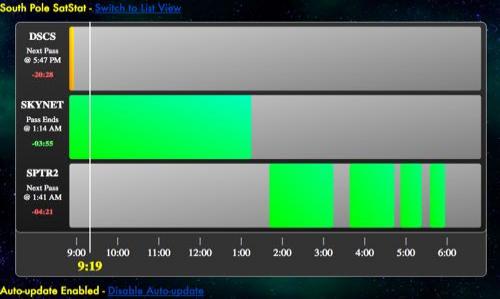 Three satellites, DSCS, SKYNET, and SPTR2 provide us with internet when they're up. Here is today's schedule for when to expect internet access.
Three satellites, DSCS, SKYNET, and SPTR2 provide us with internet when they're up. Here is today's schedule for when to expect internet access.
I plug the Ethernet cord in and hop online. Gmail struggles to open my emails and Facebook won’t load at all. I paste the content of my latest journal into the editor and click “post.” Sitting there in suspense, several minutes pass before an error message comes up. It’ll take another few attempts to get a journal posted. I can’t wait until DSCS is fixed – the connectivity is so much better than SPTR2!
3:30am-10:00am – Try to Sleep
After a frustrating few hours, my journal is posted and a few emails are sent. The satellite sets and my laptop goes offline again. Time to catch a few more hours of sleep until my day really begins.
10:00am-10:30am – Rise & Shine
I allow myself to sleep in, tired from my mid-night internet session. I throw on a hat (it’s been three days since I showered) and change from my pjs to jeans and a sweatshirt.
Unfortunately, I’ve woken up too late for breakfast. Nonetheless I walk upstairs to the Galley. I open the leftovers fridge and find pancakes and a vegetable quiche still steaming. I join the others who overslept breakfast and enjoy the view through the window – sunny, white and flat. Antarctica sure is beautiful.
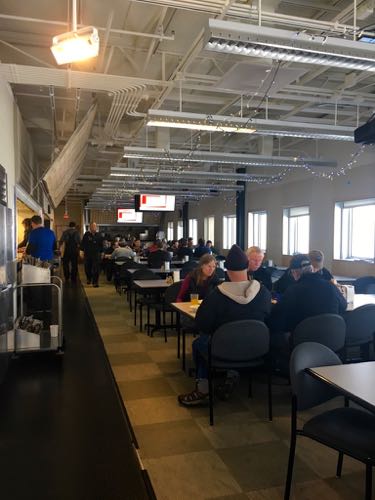 The Galley at lunchtime.
The Galley at lunchtime.
After reading The Times to catch up on what’s happening back home I turn my gaze to the monitor overhead. Informative slides fill the screen – the flight schedule, internet access schedule, store and mail room hours, upcoming events (science talks, guitar lessons, yoga, etc.), food menu for the week, and current weather. Windchill of -40F today – not bad as long as the wind keeps down.
 Today's weather…it's a bit chilly.
Today's weather…it's a bit chilly.
I carefully sort my waste into the proper bins – tea bags in one, landfill trash in the next, recyclables in another, and food waste in the last. Placing my dishes in the washing area, I exit the Galley.
As I pass people in the hall, I know almost everyone by name. There are only 150 people here after all. “Hi Dave! How are you Shannon? You just wake up Kyle?”
10:30am-12:00pm – Morning Work
I make my way to the Science Lab, more commonly known as B-2. I walk to the IceCube area, sandwiched between the South Pole Telescope crew and Meteorology.
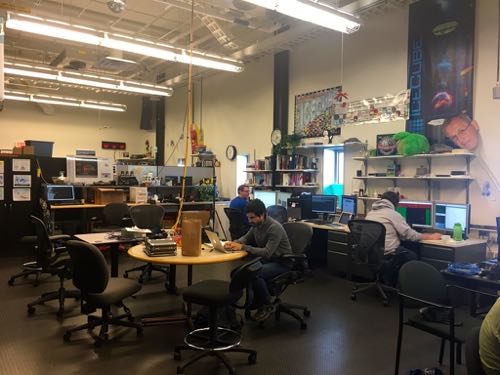 A view of the Science Lab in Room B-2. Martin, James and Michael are hard at work this morning.
A view of the Science Lab in Room B-2. Martin, James and Michael are hard at work this morning.
Here, I find Michael and Samuel hard at work on flasher runs. Each DOM has 12 little LED lights on it. Even though the DOMs themselves are deep in the ice, these lights can be controlled back in the lab. Michael and Samuel have written code to change which lights turn on when and with what intensity. As the lights turn on and off, surrounding DOMs detect that light. The data from the DOMs goes back to the lab, is transferred to hard drives, and shipped north where scientists comb through the data for several weeks trying to learn about how well the array of DOMs is functioning as well as the properties of the ice itself. They’ll be busy for the next few hours with this.
James and Martin, the winter-overs, closely monitor the incoming data on their computer screen. Is everything functioning properly with IceCube? One of them is always on-call in case something needs immediate attention.
Mike is already out with Ming and Keiichi. I’ll have to catch up with them at lunch.
Realizing we’ll be working at the station for the morning, my focus shifts to writing my next journal. I prefer to write somewhere without too many distractions. My favorite place is the greenhouse. It has a small, comfortable seating area. Cucumbers hang over my head, the smell of basil fills the room, and the lettuce is a bit taller than the last time I was here. Best of all, there’s humidity in the greenhouse. This is a welcome escape from the super dry air at the South Pole.
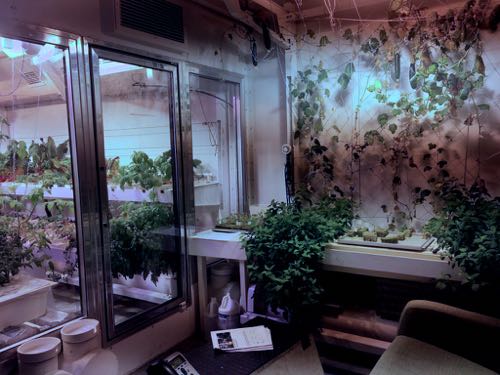 The Greenhouse at the South Pole Station. The humidity in here feels so nice!
The Greenhouse at the South Pole Station. The humidity in here feels so nice!
As I sort through pictures and construct my next entry, I can’t help but think about what everyone’s doing back home. We’re 18 hours ahead here at the South Pole, so my late morning is your yesterday dinnertime. I wonder what you’re up to.
12:00pm-1:00pm – Lunch
Lunchtime rolls around and the Galley fills up. Today is grilled cheese and tomato soup day! The two chefs here, “Big Country” and Hunter, keep us extremely well fed. They’ve even made peanut butter chocolate bars for dessert. I indulge.
A few tourists have come in from their camp to take pictures at the Ceremonial South Pole. I can see them through the Galley window. The tourist camp isn’t far away – just about a mile or so. Tourists aren’t allowed on station (unless invited or in case of an emergency).
The IceCube group discusses the plan for the afternoon – we have a hole to dig and cables to lay in a trench. Meet at D-Z (Door Z) in 10 minutes wearing full Extreme Cold Weather (ECW) gear.
We disperse.
1:00pm-5:30pm – Working Outside
I head back to my dorm, Pod A-4 Room 120. I’ll need the full 10 minutes just to get dressed in my ECW.
First my wool leggings and shirt go on. I layer on fleece pants and snowpants on top. Two pairs of socks go on and I slip my feet into my Bunny Boots. I open the valves to allow warm air to flow into my boots. Air is a great insulator and will surely help keep my feet warm. Over my shirt I put a sweatshirt, a puffy jacket, and a fleece. Layering is key, especially when digging – you don’t want to get too hot you sweat, but being underdressed is also miserable (and dangerous!).
On goes my parka known more commonly as “Big Red.” A gator and balaclava protect my neck, face, and ears, and a hat and polarized goggles complete the look. I slather on sunscreen to the little exposed skin on my face and pack it in my backpack for reapplication later. I check my pockets for 2 glove liners, mittens, thick gloves, and my camera. I have over 20 pounds of gear on now. It’s heavy, but warm. I waddle out my dorm room to D-Z where the gang is waiting.
 All suited up in my Extreme Cold Weather (ECW) gear.
All suited up in my Extreme Cold Weather (ECW) gear.
Mike has already gotten the PistenBully for us – a vehicle made for getting around in the snow and ice.
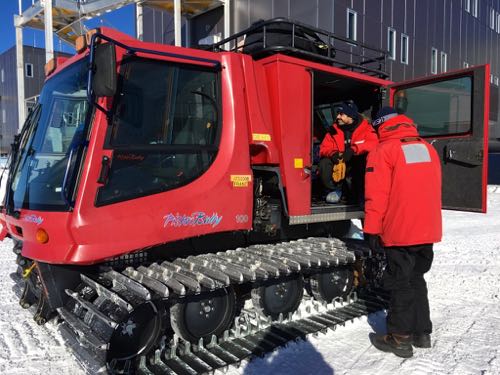 The trusty PistenBully that helps us get around on snow and ice.
The trusty PistenBully that helps us get around on snow and ice.
We pile in the back and the PistenBully jerks to life. Sliding out of the station we hit the “road”…and by road I mean the area of slightly more packed snow. It’s crammed in the back of the PistenBully with all of us today. We bounce around as Mike goes “off-roading” through the waves of snow. We’re heading to the IceCube Lab (ICL) to get some equipment.
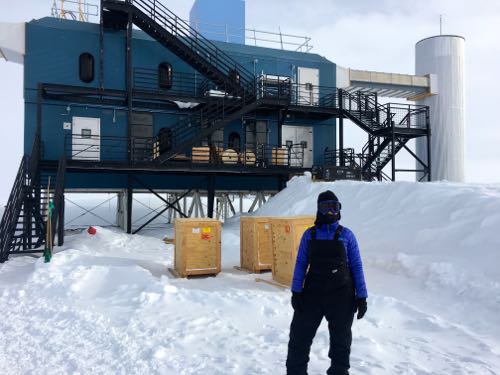 Standing outside the IceCube Lab (ICL). This is where we spend the majority of our time when we're not at the Station. See that metalic tube on the right (there's one on the left too)? That's where the cables from the DOMs come out of the ground and into the ICL.
Standing outside the IceCube Lab (ICL). This is where we spend the majority of our time when we're not at the Station. See that metalic tube on the right (there's one on the left too)? That's where the cables from the DOMs come out of the ground and into the ICL.
From ICL we start off towards ARA 1. It hasn’t been functioning properly and we need to take a look at the instruments to see if it can be fixed.
ARA, or the Askaryan Radio Array, is another scientific project here at the South Pole. This detector is looking for even higher-energy neutrinos than IceCube. Instead of looking at the blue light (Cherenkov Radiation) like IceCube does, ARA is tuned to detect radio waves (from the Askaryan Effect).
Our first task this afternoon is to dig up ARA 1. All of the instruments for ARA 1 are housed in a large box. Unfortunately, this box lies under several feet of snow. Although it doesn’t snow often at the South Pole, the existing snow does drift quite quickly. We grab our shovels and start digging.
 Digging a deep hole to get to the ARA 1 equpment. It's tiring work so we switch out who digs to give each other a break.
Digging a deep hole to get to the ARA 1 equpment. It's tiring work so we switch out who digs to give each other a break.
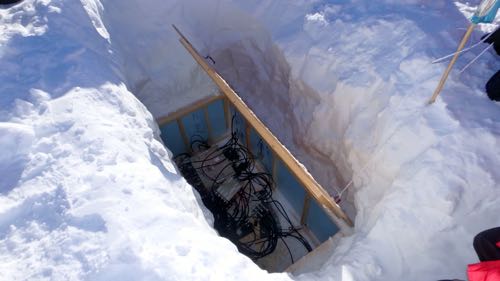 The buried treasure we've been digging for - a box full of equipment at ARA 1.
The buried treasure we've been digging for - a box full of equipment at ARA 1.
We take turns so that no one person gets too exhausted. The combination of the cold, the altitude, and the restricting gear make this a tough job. I strip off layers the warmer I get, trying to prevent myself from sweating so moisture doesn’t make me colder when I stop.
After what feels like forever spent digging, we’ve reached the box. It’s about 6 feet down. We retrieve the equipment from ARA 1 to take back to ICL. Mission accomplished. Now for a little break.
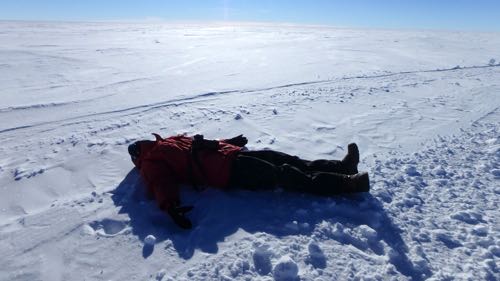 Samuel catches some rays on our break. I'm not sure he's going to get too tan with all of his gear on!
Samuel catches some rays on our break. I'm not sure he's going to get too tan with all of his gear on!
Next year, three more ARA stations are being deployed. This year, we’re laying the foundation to make that happen. Earlier in the day, a 3-foot deep trench was dug out. It is now our job to lay a power cable and a fiber optic cable in the trench so it’s all set for next year.
 This is the trench that never ends…but seriously, it goes on for over a mile! You can see Mike and Michael in the distance laying the power cable and fiber optic cable into the trench. Next year these cables will be all ready to go for the deployment of three more ARA stations.
This is the trench that never ends…but seriously, it goes on for over a mile! You can see Mike and Michael in the distance laying the power cable and fiber optic cable into the trench. Next year these cables will be all ready to go for the deployment of three more ARA stations.
There are a few challenges with this task. First of all, the trench is over one mile long. Second, while the power cable can be unraveled using machinery, the fiber optic cable is much more delicate and must be unraveled by hand. So we assign jobs – three people unraveling the fiber optic cable (it’s hard work so we need to switch frequently), one person feeding the power cable into the trench, one person feeding the fiber optic cable into the trench, and one person driving the PistenBully so we’re not stranded without transportation at the other end. It’s at least a six-person job.
I don’t know if you’ve every walked 1 ¼ miles wearing 20 pounds of gear in -40F wind chill feeding cable into a trench while trying not to fall in yourself. Probably not. Well, it’s exhausting. But I didn’t mind it one bit because whenever I looked up, there was Antarctica spread out in front of me. Beautiful, gorgeous, pure ice for miles and miles. Nothing in sight but a few flags marking the trench and the mid-day sun. Stunning.
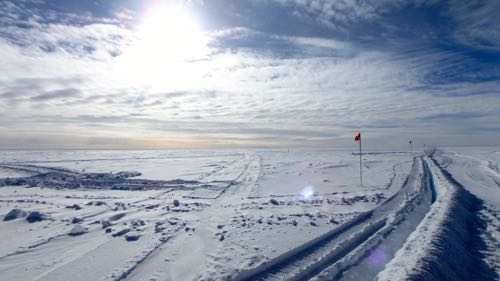 A view from one of the farthest away ARA stations. I'm looking out over miles and miles of white desert. Only a few dozen people have every set foot here.
A view from one of the farthest away ARA stations. I'm looking out over miles and miles of white desert. Only a few dozen people have every set foot here.
5:30pm-6:30pm – Dinner
We make it back in time for dinner and warm up with a hot-chocolate appetizer. Tonight is pizza night – white pizza, veggie pizza, pepperoni pizza… every type of pizza you could want. With a side of “freshies” (fresh fruit), dinner is really a treat.
As a team, we review what we’ve accomplished for the day and what needs to be done tomorrow.
6:30-10:30pm – Freetime
I check the activities corner to see what’s going on tonight.
[Activities Board]
Most nights, we’ll get together to play games in the Galley or watch a movie in the lounge. But tonight is special. With the 2017 South Pole International Film Festival (SPIFF) coming up, a replay of last year’s submissions is in order. The whole station gathers in the Galley to watch and laugh. Cookies are plentiful and an evening tea is in order.
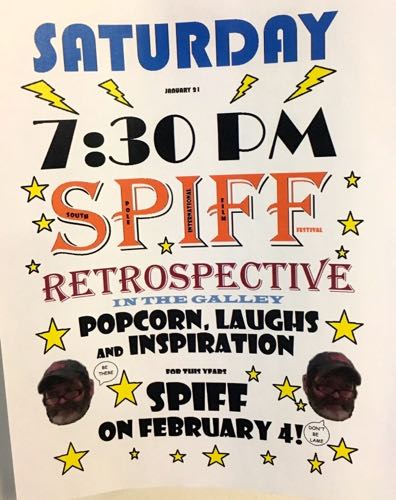 The advertisement for SPIFF - the South Pole International Film Festival.
The advertisement for SPIFF - the South Pole International Film Festival.
After, everyone heads over to a party. There are decorations all around, a platter of cheese and crackers is out, and a photo booth area is set up. Some people are wearing costumes, others are “dressed up” in their finest button down flannel shirts. It’s a fun night full of telling stories and making new friends.
10:30pm-11:00pm – Get Ready for Bed
Around 10:30 I start to get ready for bed. Today is shower day (we are allotted two showers a week). I’ve never been so excited for a shower. It’s over quickly, just two minutes are allowed. But to have moisture on my skin and clean hair feels awesome. I’ll never take a shower for granted again!
I hang up my soaking wet towel in my dorm room (there’s a built-in clothesline) in the hopes that some of the moisture will evaporate into the air making my room a little less dry for the night. It’s a valiant effort, but there’s no difference as far as I can tell.
I head to the lounge to unwind and watch some pre-downloaded Netflix shows. I’m getting tired from the work we did today.
10:30pm-1:30am– Sleep
Time to catch some z’s before I wake up in the middle of the night to use the internet. DSCS is still down, so I’ll set an alarm for 1:30am once again. So I’ll put the cardboard over my window to block out the sun, climb into my loft bed, and think about all the things that happened in yet another day at the South Pole. Goodnight!


Comments
Add new comment